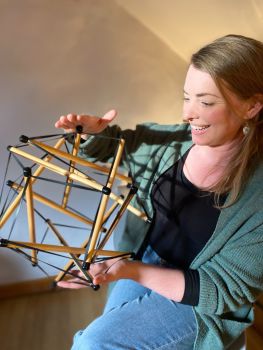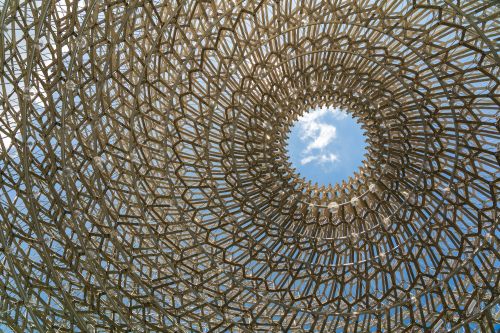What is Biotensegrity and Why Does it Matter?
Posted on
 As a body worker, I prefer to avoid technical language if it isn’t shared by my clients. I’m more interested in moving beyond a clinical expert/passive patient dynamic, preferring instead an approach that belives that you the client are the expert in what your body is saying. I can be an expert at asking the right questions, either verbally or with my hands, but ultimately it is you that has the answers. However, there is something important to explore first; the way the language we use informs the way we see and experience our bodies. A great deal of the information that we gather about our bodies is rarely from our bodies. Many of us have come to understand our bodies and how they function from an external, reductionist medical model rather than a felt, internal, holistic viewpoint, and this may be preventing us from having a truly connected, self-aware perception. There are a lot of common misconceptions and poor mechanical analogies that are used to describe body systems, particularly the muscular and skeletal systems, even the fact that systems are seen separately gives a false impression of their function and form. So, in the interest of improving body literacy, I'd like to share with you, what I think is a really useful concept that can help build a more body centred approach to human biology; biotensegrity.
As a body worker, I prefer to avoid technical language if it isn’t shared by my clients. I’m more interested in moving beyond a clinical expert/passive patient dynamic, preferring instead an approach that belives that you the client are the expert in what your body is saying. I can be an expert at asking the right questions, either verbally or with my hands, but ultimately it is you that has the answers. However, there is something important to explore first; the way the language we use informs the way we see and experience our bodies. A great deal of the information that we gather about our bodies is rarely from our bodies. Many of us have come to understand our bodies and how they function from an external, reductionist medical model rather than a felt, internal, holistic viewpoint, and this may be preventing us from having a truly connected, self-aware perception. There are a lot of common misconceptions and poor mechanical analogies that are used to describe body systems, particularly the muscular and skeletal systems, even the fact that systems are seen separately gives a false impression of their function and form. So, in the interest of improving body literacy, I'd like to share with you, what I think is a really useful concept that can help build a more body centred approach to human biology; biotensegrity.
This is the name given to explain the structure of the fascial matrix. “Bio", pertains to describing an organic rather than mechanical system, and “tensegrity” being a term borrowed from architecture and engineering to explain a system that has a structure that gets it’s strength from a tensional organisation pattern that allows for universal absorption of force and compression. In biological terms, it is a very energy efficient system; counter-force is mobilised through compression and reorganisation of matter. It is seen at the microscopic level in the cells of all living things and is a pattern reflected throughout nature.

The architecture at Kew Gardens was commissioned to reflect this repeated spiral tensegrity form in nature which you might find useful to see;
These architectural interpretations can support a visual appreciation of the continuity of the structure but clearly are limited in representing the communication strategies that are mobilised by the fascial matrix. As a physical construct fascia has a biotensegrity organisation, but it is also much more than that, it is a web-like organisation of connective tissue that includes bones and muscles and nerves and blood supply and lymph and all of the organs in one entirely continuous network.
Why this matters so much in understanding strategies of healing and resolving muscular-skeletal pain, poor posture, tension, scar tissue and adhesions for instance, is that the concept of a isolated local response pattern which is what most of us are led to believe, is less meaningful when you consider the three-dimensional quality and interconnectedness of the system. It is more meaningful to consider whole system responses to the environment and to the initiation of movement, not short kinetic lever and pulley analogies that we were taught in terms of bending your arm or leg but body-wide simultaneous spontaneous organisation of nerve, bone and muscle tissue whenever the body moves or balances or even maintains stillness.

Balance is a really good way to physically experience biotensegrity in action. Because it requires a lot of subtle and continuous readjustments.
Picture yourself on a tube train, holding on, imagine how your body is continually adjusting to the motion of the train, the proximity of other passengers and the changing speed. From the soles of your feet to the muscles in your face, this is a great real time example of how quickly the body is able to adapt in whole body way to a changing physical environment.
All tissue is connected within a biotensegrity model and any impact, disfunction or force applied to any area has a far-reaching effect, often way beyond the initial site of tension, injury or surgical incision. There can be seen a ripple or, more accurately, a spiralling effect throughout the whole body in response to injury and also in response to restorative intervention, such as bodywork or therapeutic exercise.
I feel that it is so helpful to have a visual concept of our bodies as three-dimensional, biotensegral structures so that we honour the patterns and learn to interpret the reality of how things show up for us, rather than feeling surprised that there are intrinsic connections throughout the whole body. I often have clients say that they feel like they are falling apart; I have pain in my neck and my shoulder and also my opposite hip and yes, now you mention it the arches of my feet are really stiff and I get numbness in my big toe. These kind of global patterns of pain and dysfunction are a normal part of the fascial network effectively compensating and sharing the load. They are not just a series of unrelated painful parts they are (usually) intrinsically connected with one another.
In the body there are no full stops, no separate departments, there is differentiation and specialisation but there is an over-arching management of the whole system and that is the fascia.
I hope you have enjoyed this brief opportunity to re-think your body, through the biotensegral lens. If you enjoy it, I will add more bite-sized information blogs about fascia and biotensegrity and if you have any specific questions, I’d enjoy having a go at answering them.
Photo credits: zsun-fu-hsIDivLEF9I-unsplash.jpg & nick-fewings-77oGBhrz_0A-unsplash.jpg